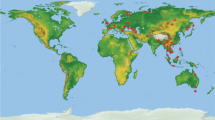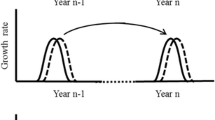Summary and Conclusions
The shoot apex ofpodocarpus gracilior exhibits an organization with four cytohistological zones, (1) the surface layer, which is distinguishable into (a) the apical initials, and (b) the surface layer on the flanks, (2) the subapical initials, (3) the flanking zone, and (4) the pith mother cells and pith.
The shoot apex exhibits differences during the seasons of the year and passes through (i) the Resting period during December to February, (ii) the Period of bud expansion, during March and April, and (iii) the Period of new bud formation, during May to November. This latter period includes cataphyll formation during May and June, enlargement of the apex during July, initiation of leaf primordia at the end of July, differentiation of the crown and the beginning of the resting period in December. During these changes the shoot apex shows differences in topography, activity and details and extent of the cytohistological zones.
Similar content being viewed by others
References
Al Sherifi, K. A. .. “Histological studies on the shoot apices and leaves of certain Cupressaceae,”Ph.D. Dissertation, Univ. of California, Berkeley, California, 1952.
Bileski, R. L... “Factors affecting growth and distribution of Kauri (Agathis australis Salisb.), III,”Austral. J. bot., 1959,7, 279–94.
Brownlie, G... “Embryogeny of the New Zealand species of the genusPodocorpus, section Eupodocarpus,”Phytomorphology, 1953,3, 295–306.
Gunckel, J. E. and Wetmore, R. H. “Studies of development in long shoots and short shoots ofGinkgo biloba, I,”Amer. J. Bot., 1946,33, 285–95.
—— and Thimann, K. V... “Studies of development in long shoots and short shoots ofGinkgo biloba, III,” Ibid., 1949,36, 145–51.
——, —— and Wetmore, R. H. “Studies of development in long shoots and short shoots ofGınkgo biloba, IV,” Ibid., 1949,36, 309–16.
Jackman, Valerie, H... “The shoot apex of some New Zealand gymnosperms,”Phytomorphology, 1960,10, 145–57.
Johnson, Marion, A... “The shoot apex in gymnosperms,” Ibid., 1960,1, 188–204.
Kemp, Margaret.. “Morphologic and ontogenetic studies onTorreya californica Torr., I,”Amer. J. Bot., 1943,30, 504–17.
Korody, E... “Studien am Spross-Vegetationspunkt vonAbies concolor, Picea excelsa undPinus montana,”Beiträge Biol. Pflanzen., 1937,25, 23–59.
Lewis, F. J. and Dowding, E. S. “The anatomy of the buds of the Conifereae,”Ann. Bot. (Lond.), 1924,38, 217–28.
Parke, R. V... “Growth periodicity and the shoot tip ofAbies concolor,”Amer. J. Bot., 1959,48, 8–16.
Sacher, J. A... “Structure and seasonal activity of the shoot apices ofPinus lambertiana andPinus ponderosa,” Ibid., 1954,41, 749–59.
Singh, H... “Seasonal variations in the shoot apex ofCephalotaxus drupacea Siebet Zucc.,”Phytomorphology, 1961,11, 146–53.
Strasburger, E. ..Die Coniferen und die Gnetaceen, Jena, 1872.
Author information
Authors and Affiliations
Additional information
Communicated by Dr. V. Puri,f.a.sc.
Rights and permissions
About this article
Cite this article
Pillai, S.K. Zonal structure and seasonal variations in the shoot apex ofPodocarpus gracilior pilger. Proc. Indian Acad. Sci. 57, 58–67 (1963). https://doi.org/10.1007/BF03053883
Received:
Issue Date:
DOI: https://doi.org/10.1007/BF03053883




